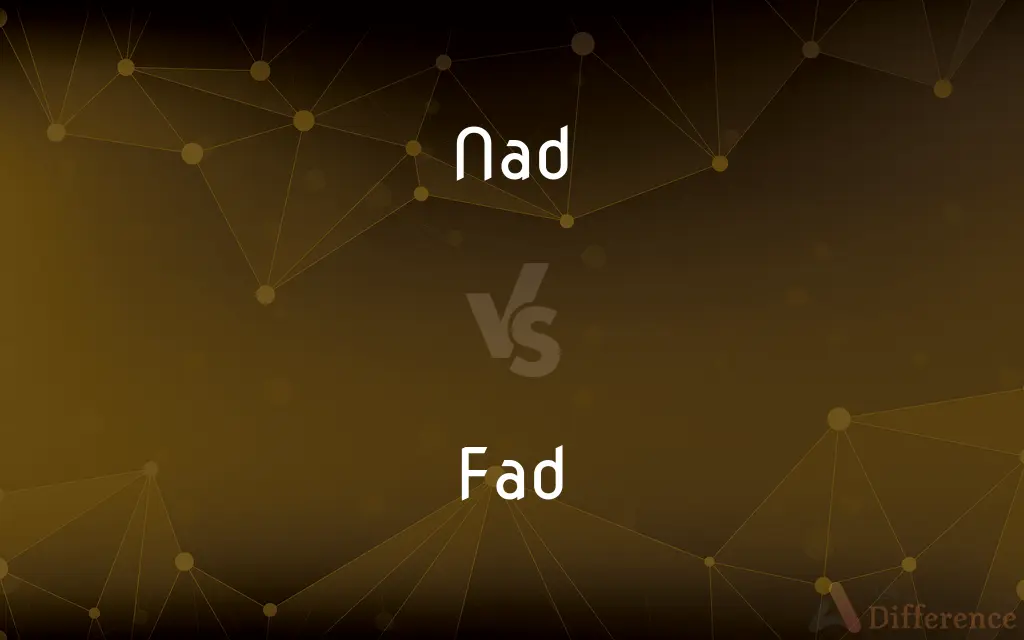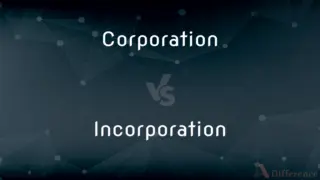NAD vs. FAD — What's the Difference?
By Tayyaba Rehman & Urooj Arif — Updated on April 17, 2024
NAD (Nicotinamide adenine dinucleotide) and FAD (Flavin adenine dinucleotide) are both essential cofactors in cellular redox reactions, but NAD is more involved in catabolic reactions while FAD is integral in both catabolic and anabolic pathways.

Difference Between NAD and FAD
Table of Contents
ADVERTISEMENT
Key Differences
NAD is a coenzyme found in all living cells and is primarily involved in oxidation-reduction reactions, where it alternates between NAD+ (oxidized form) and NADH (reduced form). It plays a crucial role in metabolic processes such as glycolysis and the Krebs cycle, primarily involved in energy production. FAD, another vital coenzyme, also participates in redox reactions but is unique in its ability to accept two electrons, oscillating between FAD (oxidized form) and FADH2 (reduced form). FAD is notably significant in both catabolic processes like the Krebs cycle and anabolic processes such as fatty acid synthesis.
While NAD is mainly involved in pathways that break down molecules to release energy, FAD is critical in processes that require energy input and output, illustrating its versatility. The biochemical pathways preferentially utilizing NAD often generate ATP through substrate-level phosphorylation or oxidative phosphorylation, whereas FAD is integral in reactions that are part of the electron transport chain, which also contributes to ATP synthesis.
NAD can be synthesized from tryptophan or nicotinic acid, showing a dietary dependency for its availability. In contrast, FAD is synthesized from riboflavin (vitamin B2), highlighting different nutritional requirements to maintain adequate levels of these coenzymes.
In terms of cellular location, NAD is predominantly found throughout the cell, including in the cytosol and mitochondria, reflecting its broad role in cellular metabolism. FAD, however, is primarily localized in the mitochondria, closely associated with specific enzymes that facilitate its involvement in the electron transport chain and other metabolic pathways.
The importance of NAD in aging and disease is increasingly recognized, with research focusing on its role in sirtuin activation and overall cellular health. FAD also plays a role in clinical conditions, particularly in diseases where metabolism is disrupted, such as in certain types of cancer and mitochondrial disorders.
ADVERTISEMENT
Comparison Chart
Primary Role
Oxidation-reduction reactions
Participates in both catabolic and anabolic reactions
Electron Acceptance
Accepts one electron to form NADH
Accepts two electrons to form FADH2
Metabolic Pathways
Glycolysis, Krebs cycle
Krebs cycle, electron transport chain, fatty acid synthesis
Synthesis Source
Tryptophan, nicotinic acid
Riboflavin (Vitamin B2)
Localization
Cytosol, mitochondria
Primarily mitochondria
Compare with Definitions
Nad
A coenzyme involved in redox reactions, crucial for energy production.
NAD+ is reduced to NADH during glycolysis.
Fad
Involved in both energy-releasing and energy-consuming reactions.
FAD is essential in fatty acid synthesis and degradation.
Nad
Influences health and disease states.
Adequate NAD levels are linked to reduced signs of aging and better metabolic health.
Fad
A coenzyme that plays a critical role in energy production and nutrient metabolism.
FADH2 is formed during the Krebs cycle.
Nad
Can be synthesized from dietary precursors.
Niacin, a form of vitamin B3, is vital for NAD production.
Fad
Derived from vitamin B2, indicating a dietary need to maintain its levels.
Riboflavin deficiency can lead to reduced FAD in cells.
Nad
Found in all living cells, essential for metabolic activities.
NAD+ is a key player in the oxidative phosphorylation process.
Fad
Implicated in various metabolic disorders.
FAD-linked metabolic pathways are studied in the context of mitochondrial diseases.
Nad
Participates in cellular signaling and regulation.
NAD levels influence sirtuin activity, affecting aging and metabolism.
Fad
Predominantly found in mitochondria, associated with specific enzymes.
FAD-dependent glucose dehydrogenase aids in glucose metabolism.
Nad
A testicle.
Fad
A fad, trend, or craze is any form of collective behavior that develops within a culture, a generation or social group in which a group of people enthusiastically follow an impulse for a short period. Fads are objects or behaviors that achieve short-lived popularity but fade away.
Nad
A coenzyme, C21H27N7O14P2, occurring in most living cells and utilized alternately with NADH as an oxidizing or reducing agent in various metabolic processes.
Fad
A fashion that is taken up with great enthusiasm for a brief period of time; a craze.
Nad
Had not.
Fad
A phenomenon that becomes popular for a very short time.
Nad
A coenzyme present in most living cells and derived from the B vitamin nicotinic acid; serves as a reductant in various metabolic processes
Fad
A hobby ; freak; whim.
It is your favorite fad to draw plans.
Fad
A practise followed enthusiastically by a number of people for a limited period of time; as, the latest fad in fashion.
Fad
An interest followed with exaggerated zeal;
He always follows the latest fads
It was all the rage that season
Common Curiosities
What happens when there is a deficiency of NAD or FAD?
Deficiencies can lead to metabolic disruptions, affecting energy production and overall cellular function, potentially resulting in clinical symptoms or diseases.
Why are NAD and FAD important in cellular metabolism?
Both are crucial for transferring electrons in the cellular redox reactions essential for metabolizing carbohydrates, fats, and proteins, thereby producing ATP.
How do dietary needs influence the levels of NAD and FAD in the body?
NAD levels are influenced by intake of tryptophan and niacin (vitamin B3), while FAD levels depend on the intake of riboflavin (vitamin B2).
What is the main functional difference between NAD and FAD?
NAD primarily participates in redox reactions by cycling between NAD+ and NADH, mainly in energy production, whereas FAD participates in both catabolic and anabolic pathways, cycling between FAD and FADH2.
Can NAD and FAD be interconverted?
No, NAD and FAD are distinct molecules and function independently in different metabolic pathways.
How do NAD and FAD contribute to ATP synthesis?
NADH and FADH2 donate electrons to the electron transport chain, which ultimately leads to ATP production through oxidative phosphorylation.
Why is FAD especially important in mitochondria?
FAD is integral to mitochondrial enzymes that are crucial for energy production and fatty acid metabolism.
Are NAD and FAD antioxidants?
While not antioxidants themselves, they play critical roles in the cellular redox state and influence the overall oxidative stress in cells.
What role does NAD play in aging?
NAD influences the activity of sirtuins and other regulatory proteins involved in aging and longevity.
Can supplements of NAD and FAD improve health?
Supplements aimed at boosting NAD and riboflavin levels can improve metabolic health, but their effectiveness varies depending on individual health conditions and needs.
Share Your Discovery

Previous Comparison
Corporation vs. Incorporation
Next Comparison
Bowl vs. PlateAuthor Spotlight
Written by
Tayyaba RehmanTayyaba Rehman is a distinguished writer, currently serving as a primary contributor to askdifference.com. As a researcher in semantics and etymology, Tayyaba's passion for the complexity of languages and their distinctions has found a perfect home on the platform. Tayyaba delves into the intricacies of language, distinguishing between commonly confused words and phrases, thereby providing clarity for readers worldwide.
Co-written by
Urooj ArifUrooj is a skilled content writer at Ask Difference, known for her exceptional ability to simplify complex topics into engaging and informative content. With a passion for research and a flair for clear, concise writing, she consistently delivers articles that resonate with our diverse audience.














































